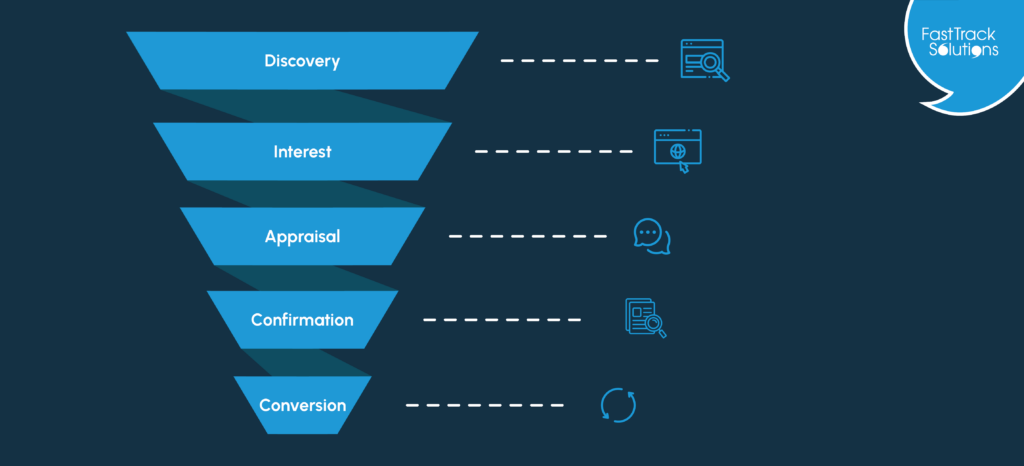If you want to attract potential customers and build a pipeline of genuine new business opportunities, there’s a high chance you’ll need to devise a lead generation strategy. Lead generation goes hand in hand with your existing inbound marketing strategy, and is the way you’ll generate sales opportunities for your sales team to convert to customers. But what exactly is lead generation?
Read on to learn more about lead generation, how to generate quality leads, and how to increase your chances of converting them to a sale.
What is Lead Generation?
As part of the pre-sales process, lead generation involves attracting and engaging prospects, and exploring their needs and motivations, with the goal of converting them into a customer later in the process.
Lead generation is a vital part of the sales funnel for B2B business, particularly as the development of products and services can be a costly process. Lead generation helps to increase brand awareness for companies, gather market intelligence, and generate a sales pipeline, leading to increased sales revenue with leads converting to customers.
For lead generation to take place, you should first be able to identify and target your ideal customers, exploring their goals and challenges to understand if they have a need and motivation for the kind of product or solution that you provide.
Types of leads:
For a person or business to be a ‘lead’ it is simply that you have confirmed the individual you’ve spoken with has expressed interest in engaging, and may have a forthcoming requirement or motivation for your product/solution.
However not all leads are created equal, as they are all qualified differently depending on what information you have gathered.
Leads can be categorised this way, to determine what level of qualification they are at.
What is an MQL?
MQL stands for ‘marketing qualified lead’ and is a type of lead that may have yet to be fully ‘qualified’ (explored) by your team. This means they have shown interest in your offering, may fit a certain buyer persona, and have been generated either through the website, email campaign, or other marketing efforts.
An MQL can become an SQL once one of your team has taken the time to speak with individual(s) at that company and understood in depth their priorities and needs, at this stage it’s likely you are missing certain information to determine whether they are a decision maker, whether there is a genuine need for your services – whether the lead is of any value.
What is an SQL?
For a lead to become an SQL, it must be a sales qualified lead, meaning a member of the team has spoken with the lead contact and qualified the opportunity to understand if your business can help them meet their current or future requirements for your services.
You can find out more about the difference between an MQL and an SQL in our article.
How Do I Qualify a Lead?
Arguably the most important aspect of lead generation, lead qualification is the process of assessing the potential of a lead, based on a checklist of ‘must-have’ criteria which make the opportunity a good fit for your business.To qualify a lead, you may use the following criteria as a start point:
- Need: Determine whether the lead has a genuine need for your product or service, what are they looking for?
- Motivation: Determine the priorities of the individual who has reached out to you along with the priorities within their organisation. Are they simply gathering information and therefore aren’t seriously looking to buy? Is this purchase high on their current priorities? Are there any other goals/challenges within their world that your offering can help with to increase their motivation?
- Authority: Determine whether the lead has the authority to make purchasing decisions or is an influencer. Who else in the team would be involved in decision making?
- Timing: Determine whether the lead is ready to make a purchase or if they have a future need.
- Budget: Determine what budget the lead has to purchase your product or service.
- Fit: Determine whether the sales opportunity with the lead is a good fit for your business in terms of industry, company size, and any other factors relevant to your specific criteria.
Whether your business receives a consistent flow of inbound leads, or is looking to qualify just a small number of inbound leads, lead qualification is essential to every sales and marketing team.
To be sure teams do not waste time on opportunities which are not a good fit or do not have a genuine need for the solution you provide, lead qualification can help understand the potential of a lead, before any time is wasted.
When new leads enter the sales pipeline, follow up teams should be proactive in either qualifying or disqualifying the lead. There’s no harm in being open and respectful in letting your lead know if it is not a good fit between your two businesses. Remember, from the prospective customer’s point of view, you are saving their valuable time by openly discussing their requirements and if a follow up conversation is worth both of your collective time.
What is the Lead Generation process?
The lead generation process is a crucial part of any business strategy as it helps to identify potential customers and convert them into paying customers. Here are the key steps involved in the lead generation process:
1. Determine your strategy:
Before starting any lead generation activity, it is important to determine the strategy. This involves setting clear objectives, identifying the target audience, and deciding on the messaging that will be used to attract potential leads. A kick-off meeting is usually held to discuss these points and agree on the next steps.
2. Begin advertising/marketing business:
Once the strategy has been set, it’s time to begin advertising and marketing the business. This can be done through paid channels such as social media advertising or through organic channels such as search engine optimisation (SEO). By utilising these channels, potential leads will begin to discover the business.
3. Lead discovers business
A lead can discover the business through various means, such as seeing a social media post, coming across an advertisement, or finding the website through a Google search. At this point, the lead has shown some level of interest in the business.
4. Lead shows interest/takes action:
The lead may show interest in the business by taking action such as submitting a form, making a call, or sending an email. In some cases, the lead may be an outbound lead that the team has contacted and reached out to.
4. Qualification and nurturing:
Once the lead has taken action, the lead generation team will qualify the lead by contacting them and assessing their level of interest in the business. If the lead is qualified, a sales appointment may be arranged with them. Alternatively, the lead may be nurtured ahead of arranging a sales appointment in the future.
Overall, the lead generation process involves identifying potential customers, attracting their interest, and nurturing them until they become paying customers. By following these steps, businesses can create an effective lead generation process that helps to drive revenue and growth. The target keywords for this section are lead generation process, lead generation activity, potential leads, inbound lead, outbound lead, qualification, and nurturing.

Lead Generation Strategies
Generating leads is essential to any business that wants to build a healthy sales pipeline. There are a number of lead generation strategies that businesses can use to attract and engage prospects. In this section, we’ll explore some of the most effective lead generation strategies that businesses can use to generate leads online.
Telemarketing Prospecting Activity
Telemarketing prospecting is outbound phone calling that involves reaching out to decision makers to discuss their priorities and see if your offering can help them. Proactive telemarketing is highly effective for reaching out to your wish-list customers or existing clients to explore their need for your solution and gather market intelligence such as contract renewal dates, who their incumbent provider is, and to explore the priorities of the decision makers within the organisation. Phone prospecting can be done in tandem with other lead generation activity to ensure interest generated for your business is followed up.
Search Engine Marketing/PPC/Paid advertising:
Search engine marketing (SEM) is a paid advertising strategy that involves placing ads in search engine results pages (SERPs). With SEM, businesses bid on keywords that potential customers might use when searching for products or services online. This is a highly targeted approach to lead generation, as the ads only appear to users who are actively searching for the keywords you have bid on. This strategy is particularly effective for businesses that are looking to generate leads quickly.
Search Engine Optimisation/Organic traffic:
Search engine optimisation (SEO) is a strategy that involves optimising your website and content to rank higher in search engine results pages (SERPs) for relevant keywords. SEO can be a highly effective lead generation strategy, as it can drive organic traffic to your website and increase your visibility to potential customers. This is a long-term strategy that requires patience and persistence, but it can be highly effective in generating leads over time.
Social Media:
Social media platforms like Facebook, LinkedIn, and Twitter can be highly effective for generating leads. By creating engaging content and building a following, businesses can attract potential customers to their social media profiles and website. Social media is particularly effective for businesses that are looking to build relationships with their customers and create brand awareness.
Referrals:
Referrals are a powerful lead generation strategy, as they rely on word-of-mouth marketing and the trust that customers have in their networks. By encouraging satisfied customers to refer their friends and family to your business, you can generate high-quality leads that are more likely to convert into customers. Referral programs can be highly effective for businesses that have a loyal customer base.
Offline events:
Offline events, such as trade shows, conferences, and networking events, can be highly effective for generating leads. These events provide businesses with an opportunity to meet potential customers face-to-face and build relationships with them. By providing valuable information and engaging with potential customers, businesses can generate high-quality leads that are more likely to convert into customers.
We hope our Ultimate Guide to Lead Generation has proven useful! By exploring the ins and outs of lead generation we can help you master this essential aspect of business growth. From understanding the importance of lead generation to implementing effective strategies and leveraging digital marketing tools, you now have the knowledge to take your lead generation efforts to new heights!
However, we understand that executing a successful lead generation campaign can be a complex and time-consuming task, especially when it comes to managing a lead pipeline long term. If you’re looking for expert guidance and support to maximise your lead generation potential, we’re here to help.
At Fast Track Solutions, Lead Generation is our speciality. Whether you are looking to uncover new leads, or better manage your existing pipeline, we provide additional resources to generate new interest and actively follow up on existing leads. Our experienced team of experts understands the intricacies of lead generation and because we’ve worked with all sorts of industries, we can tailor strategies to suit your unique business needs. Why not find out more about how we work with you?
Don’t let your lead generation efforts fall short. Contact us to discuss how we can collaborate and propel your business forward. Let us be your trusted partner in achieving lead generation success and unlocking the full potential of your business.





